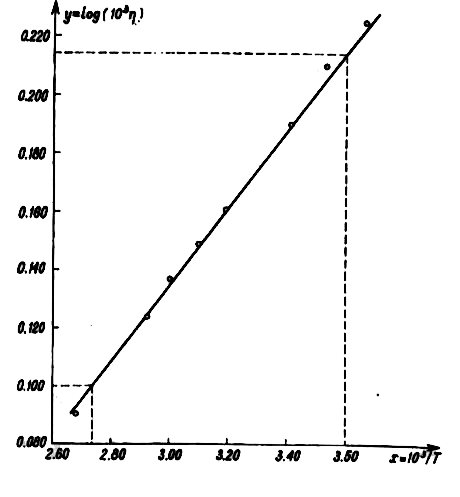The viscosity of mercury decreases with the rise in temperature (Table 21.1a). Check whether relation (34.10) is valid for mercury. Calculate the activation energy.

लिखित उत्तर
To check the exponential dependence of viscosity on temperature, find the dependence of the logarithm of viscosity on the reciprocal of the temperature. To do this, compile a new table (Table 21.1b) using the data of Table 21.1a. Using the data of the new table, plot

a graph on millimetre graph paper (Fig. 21.1). Almost all the points are seen to fall on the straight line
y=a+bx,orlog(108η)=a+100+bT=a+BT

Taking antilogarrithms we obtain
103η=A×10B/T
the distinction from formula (34.10) being only in numerical coefficients.
To find the activation energy e, use two points lying on the straight line:
x1=2.75,y1=0.100andx2=3.60,y2=0.213
The temperatures corresponding to these points are T1=103/x1=364KandT2=103/x2=278K and the corresponding visocsities
are η1=10−3×10y1=1.26×10−3 Pa, * s and η2=1.63×10−3Pa⋅s.
The ratio or the viscosities is
η2:η1=eε0/kTe,εε0/hT1=exp{ε0(T1−T2)kT1T2}
Hence we obtain after taking the logarithms
ε0(T1−T2)kT1T2=ln(η2)η1
or ε0=kT1T2ln(η2/η1)T1−T2−2.3kT1T2log(η2/η1)T1−T2
|
Updated on:21/07/2023
समान प्रश्न
The rate constant of a reaction is 1.5×107s−1 at 50∘C and 4.5×107s−1 at 100∘C. Calculate the value of activation energy for the reaction (R=8.314JK−1mol−1)
View SolutionElectromagnetic radiatio of wavelength 242 nm is just sufficient to ionise the sodium atom. Calculate the ionisation energy of sodium in kJ⋅mol−1.
View Solution
ज्ञान जांच
- Question 1 - Select One
For a certain gaseous reaction rise of temperature from 25∘C to 35∘C doubles the rate of reaction. What is the value of activation energy :-
A102.30R×298×308B0.693R×298×30810C2.303×10298×308RD0.693R×10290×308

